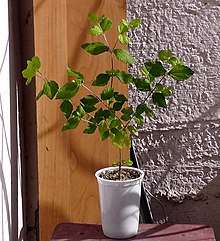Calea ternifolia
Calea ternifolia (syn. Calea zacatechichi)[1] is a species of flowering plant in the aster family, Asteraceae. It is native to Mexico and Central America.[1] Its English language common names include bitter-grass, Mexican calea,[1] and dream herb.[2]
| Calea ternifolia | |
|---|---|
| Scientific classification | |
| Kingdom: | |
| (unranked): | |
| (unranked): | |
| (unranked): | |
| Order: | |
| Family: | |
| Genus: | |
| Species: | C. ternifolia |
| Binomial name | |
| Calea ternifolia | |
| Synonyms | |
|
Calea zacatechichi Schltdl. | |
It is used in traditional medicine and ritual in its native range.[3]
Uses
In Mexico the plant is used as an herbal remedy for dysentery and fever.[3] The Zoque Popoluca people call the plant tam huñi ("bitter gum") and use it to treat diarrhea and asthma, and the Mixe people know it as poop taam ujts ("white bitter herb") and use it for stomachache and fever.[4]
The Chontal people of Oaxaca reportedly use the plant, known locally as thle-pela-kano, during divination. Isolated reports describe rituals that involve smoking a plant believed to be this species, drinking it as a tea, and placing it under a pillow to induce divinatory dreams due to its properties as an oneirogen. Zacatechichi, the former species name, is a Nahuatl word meaning "bitter grass".[5] Users take the plant to help them remember their dreams;[2] known side effects include nausea and vomiting related to the taste and mild-to-severe allergic reaction.
While quite bitter if brewed in hot water, the bitterness can be considerably masked by brewing with Osmanthus flowers, which have a compatible scent profile.
Chemical composition

Chemical compounds isolated from this species include flavones[6] such as acacetin[7] and sesquiterpene lactones such as germacranolides.[8] The sesquiterpenes known as caleicines and caleochromenes may be active in its effects on sleep.[2]
Legal status
While it is not a controlled substance under federal law in the United States, some states have considered it individually. Louisiana State Act 159 specifies that it is illegal to possess if it is intended for human consumption, but not if they are intended for ornamental or landscaping use. Tennessee proposed a bill that would have made this and many other plants classified as hallucinogenic illegal, but when the bill was passed only Salvia divinorum was banned.[9]
This plant was banned in Poland in March 2009.[2][10]
_Dream_Herb.jpg)
References
| Wikimedia Commons has media related to Calea ternifolia. |
| Wikimedia Commons has media related to Calea ternifolia. |
- "Calea ternifolia". Germplasm Resources Information Network (GRIN). Agricultural Research Service (ARS), United States Department of Agriculture (USDA). Retrieved 12 December 2017.
- Simonienko, K., et al. (2013). Psychoactive plant species – actual list of plants prohibited in Poland. Psychiatria Polska XLVII(3), 499–508.
- Ferraz, A., et al. (2009). Pharmacological and genotoxic evaluation of Calea clematidea and Calea uniflora. Latin American Journal of Pharmacy 28(6), 858-62.
- Leonti, M., et al. (2003). Antiquity of medicinal plant usage in two Macro-Mayan ethnic groups (Mexico). Journal of Ethnopharmacology 88(2), 119-24.
- Díaz, J. L. (1979). Ethnopharmacology and taxonomy of Mexican psychodysleptic plants. J Psychedelic Drugs 11(1-2), 71–101.
- Mariano, M. V., et al. (1987). Thymol derivatives from Calea nelsonii. Phytochemistry 26(9), 2577-79.
- Mayagoitia, L., et al. (1986). Psychopharmacologic analysis of an alleged oneirogenic plant: Calea zacatechichi. Journal of Ethnopharmacology 18(3), 229–43.
- Lee, I. Y., et al. (1982). New germacranolides from Calea ternifolia and the molecular structure of 9α-Hydroxy-11, 13-Dihydro-11α, 13-Epoxyatripliciolide-8β-O-(2-Methylacrylate). Journal of Natural Products 45(3), 311-16.
- Calea zacatechichi Legal Status Erowid.org. Jun 20 2006.
- (in Polish) Dz.U. 2009 nr 63 poz. 520, Internetowy System Aktów Prawnych.